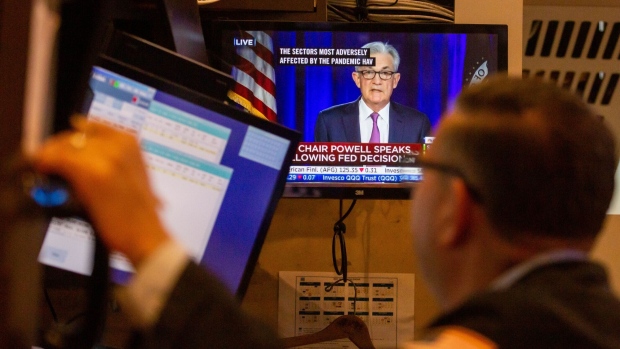Nov 3, 2023
Traders Now Bet on First US Rate Cut in June Rather Than July
, Bloomberg News

(Bloomberg) -- Treasuries rallied, with 10-year yields heading for their biggest three-day decline since the onset of the pandemic in 2020, as signs of softening US labor data fueled speculation that the Federal Reserve is done hiking interest rates.
Yields on 10-year bonds dropped 13 basis points to 4.5%, extending their decline since Tuesday to roughly 40 basis points, after a government report showed the unemployment rate rose to an almost two-year high and wage growth slowed. Over the past three decades, a move of this magnitude only occurred 10 times, prior to this week.
Rates on 2- to 10-year debt all were down more than 10 basis points on Friday.
Interest-rate derivatives show traders see only a 20% chance of another Fed rate hike by January, and have fully priced in a cut by June. Before the job report, traders had expected the first interest-rate cut in July. Interest-rate swaps tied to the December 2024 meeting traded at about 4.4%, or more than 90 basis points below the current fed funds rate.
“This employment report fits our view that the economy is slowing,” said Gregory Faranello, head of US rates for AmeriVet Securities in New York. He said he turned neutral on the bond market two weeks ago after being bearish the last three years.
The softer-than-expected jobs data is the latest source of support for bond investors this week, after a relentless selloff in recent months sent Treasury yields to the highest in more than a decade. The turnaround started on Wednesday when the Treasury said it was slowing the pace of increases in sales of long-maturity bonds, and as Fed Chair Jerome Powell hinted that the tightening cycle may be over.
The bond rally came after a number of prominent investors including Stan Druckenmiller, Bill Ackman and Bill Gross, sounded alarm about the economy. Druckenmiller said last month that he bought “massive leveraged positions” in two-year notes, while Pershing Square Capital Management’s founder Ackman said he’s unwound his bearish bets on 30-year bonds.
Friday’s job report showed that nonfarm payrolls increased a less-than-forecast 150,000 last month, following a downwardly revised 297,000 in September. The unemployment rate climbed to 3.9%, and monthly wage growth slowed.
The three-month moving average of the unemployment rate has increased 0.42 percentage point above its low from the past year. That’s large enough that it would have identified all 11 recessions since 1950 within an average of three months from their start, according to Bloomberg Economics.
“The market is responding as you expect on the weaker-than-consensus payrolls downward revisions and wages,” said Priya Misra, portolio manager at JPMorgan Investment Management.
For equity investors piling into stocks this week, the drop in yields is seen boosting chances of a soft landing for the economy. That speculation is helping send the benchmark S&P 500 poised to notch its best week this year.
The outperformance of longer-term bonds reversed the recent trend of curve steepening. At 4.55%, the 10-year yields are about 34 basis points below that of two-year rate. At the end of October, the gap was about 16 basis points, marking the least inverted in more than a year.
The bond market’s newly found bullish sentiment faces a test next week when the Treasury auctions $40 billion in 10-year notes and $24 billion in 30-year securities.
That supply looms large and bonds no longer appear “significantly cheap,” JPMorgan Chase & Co.’s strategists said Thursday, recommending clients “take profit” on their bullish bets on five-year notes.
--With assistance from Mark Tannenbaum.
(Updates pricing in second paragraph.)
©2023 Bloomberg L.P.






